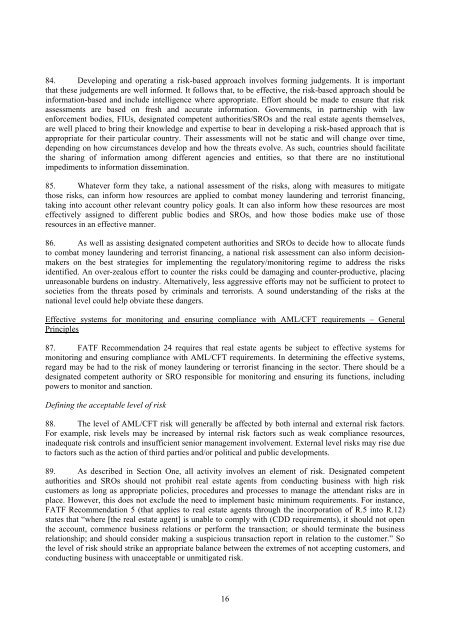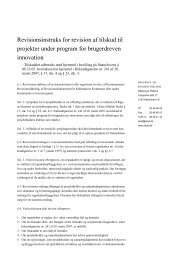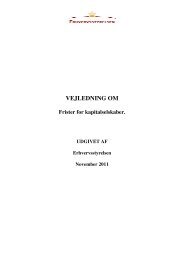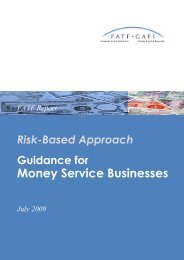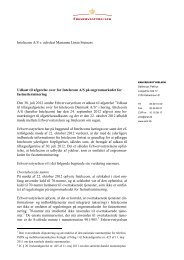RBA Guidance for Real Estate Agents.pdf - FATF
RBA Guidance for Real Estate Agents.pdf - FATF
RBA Guidance for Real Estate Agents.pdf - FATF
Create successful ePaper yourself
Turn your PDF publications into a flip-book with our unique Google optimized e-Paper software.
84. Developing and operating a risk-based approach involves <strong>for</strong>ming judgements. It is importantthat these judgements are well in<strong>for</strong>med. It follows that, to be effective, the risk-based approach should bein<strong>for</strong>mation-based and include intelligence where appropriate. Ef<strong>for</strong>t should be made to ensure that riskassessments are based on fresh and accurate in<strong>for</strong>mation. Governments, in partnership with lawen<strong>for</strong>cement bodies, FIUs, designated competent authorities/SROs and the real estate agents themselves,are well placed to bring their knowledge and expertise to bear in developing a risk-based approach that isappropriate <strong>for</strong> their particular country. Their assessments will not be static and will change over time,depending on how circumstances develop and how the threats evolve. As such, countries should facilitatethe sharing of in<strong>for</strong>mation among different agencies and entities, so that there are no institutionalimpediments to in<strong>for</strong>mation dissemination.85. Whatever <strong>for</strong>m they take, a national assessment of the risks, along with measures to mitigatethose risks, can in<strong>for</strong>m how resources are applied to combat money laundering and terrorist financing,taking into account other relevant country policy goals. It can also in<strong>for</strong>m how these resources are mosteffectively assigned to different public bodies and SROs, and how those bodies make use of thoseresources in an effective manner.86. As well as assisting designated competent authorities and SROs to decide how to allocate fundsto combat money laundering and terrorist financing, a national risk assessment can also in<strong>for</strong>m decisionmakerson the best strategies <strong>for</strong> implementing the regulatory/monitoring regime to address the risksidentified. An over-zealous ef<strong>for</strong>t to counter the risks could be damaging and counter-productive, placingunreasonable burdens on industry. Alternatively, less aggressive ef<strong>for</strong>ts may not be sufficient to protect tosocieties from the threats posed by criminals and terrorists. A sound understanding of the risks at thenational level could help obviate these dangers.Effective systems <strong>for</strong> monitoring and ensuring compliance with AML/CFT requirements – GeneralPrinciples87. <strong>FATF</strong> Recommendation 24 requires that real estate agents be subject to effective systems <strong>for</strong>monitoring and ensuring compliance with AML/CFT requirements. In determining the effective systems,regard may be had to the risk of money laundering or terrorist financing in the sector. There should be adesignated competent authority or SRO responsible <strong>for</strong> monitoring and ensuring its functions, includingpowers to monitor and sanction.Defining the acceptable level of risk88. The level of AML/CFT risk will generally be affected by both internal and external risk factors.For example, risk levels may be increased by internal risk factors such as weak compliance resources,inadequate risk controls and insufficient senior management involvement. External level risks may rise dueto factors such as the action of third parties and/or political and public developments.89. As described in Section One, all activity involves an element of risk. Designated competentauthorities and SROs should not prohibit real estate agents from conducting business with high riskcustomers as long as appropriate policies, procedures and processes to manage the attendant risks are inplace. However, this does not exclude the need to implement basic minimum requirements. For instance,<strong>FATF</strong> Recommendation 5 (that applies to real estate agents through the incorporation of R.5 into R.12)states that “where [the real estate agent] is unable to comply with (CDD requirements), it should not openthe account, commence business relations or per<strong>for</strong>m the transaction; or should terminate the businessrelationship; and should consider making a suspicious transaction report in relation to the customer.” Sothe level of risk should strike an appropriate balance between the extremes of not accepting customers, andconducting business with unacceptable or unmitigated risk.16


